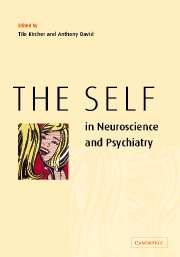Book contents
- Frontmatter
- Contents
- List of contributors
- Introduction: the self and neuroscience
- Part I Conceptual background
- Part II Cognitive and neurosciences
- 5 The multiplicity of consciousness and the emergence of the self
- 6 Asynchrony, implicational meaning and the experience of self in schizophrenia
- 7 Self-awareness, social intelligence and schizophrenia
- 8 The neural correlates of self-awareness and self-recognition
- 9 Autonoetic consciousness
- 10 The neural nature of the core SELF: implications for understanding schizophrenia
- Part III Disturbances of the self: the case of schizophrenia
- 11 Self and schizophrenia: a phenomenological perspective
- 12 Self-disturbance in schizophrenia: hyperreflexivity and diminished self-affection
- 13 The self-experience of schizophrenics
- 14 The paranoid self
- 15 Schizophrenia and the narrative self
- 16 Self-narrative in schizophrenia
- 17 Schizophrenia as disturbance of the self-construct
- 18 Action recognition in normal and schizophrenic subjects
- 19 Disorders of self-monitoring and the symptoms of schizophrenia
- 20 Hearing voices or hearing the self in disguise? Revealing the neural correlates of auditory hallucinations in schizophrenia
- 21 The cognitive neuroscience of agency in schizophrenia
- 22 Self-consciousness: an integrative approach from philosophy, psychopathology and the neurosciences
- References
12 - Self-disturbance in schizophrenia: hyperreflexivity and diminished self-affection
from Part III - Disturbances of the self: the case of schizophrenia
Published online by Cambridge University Press: 18 December 2009
- Frontmatter
- Contents
- List of contributors
- Introduction: the self and neuroscience
- Part I Conceptual background
- Part II Cognitive and neurosciences
- 5 The multiplicity of consciousness and the emergence of the self
- 6 Asynchrony, implicational meaning and the experience of self in schizophrenia
- 7 Self-awareness, social intelligence and schizophrenia
- 8 The neural correlates of self-awareness and self-recognition
- 9 Autonoetic consciousness
- 10 The neural nature of the core SELF: implications for understanding schizophrenia
- Part III Disturbances of the self: the case of schizophrenia
- 11 Self and schizophrenia: a phenomenological perspective
- 12 Self-disturbance in schizophrenia: hyperreflexivity and diminished self-affection
- 13 The self-experience of schizophrenics
- 14 The paranoid self
- 15 Schizophrenia and the narrative self
- 16 Self-narrative in schizophrenia
- 17 Schizophrenia as disturbance of the self-construct
- 18 Action recognition in normal and schizophrenic subjects
- 19 Disorders of self-monitoring and the symptoms of schizophrenia
- 20 Hearing voices or hearing the self in disguise? Revealing the neural correlates of auditory hallucinations in schizophrenia
- 21 The cognitive neuroscience of agency in schizophrenia
- 22 Self-consciousness: an integrative approach from philosophy, psychopathology and the neurosciences
- References
Summary
Abstract
The present chapter offers a unifying but nonreductive interpretation of schizophrenia, one that attempts to show how the diverse signs and symptoms of this illness may all be rooted in certain fundamental alterations in the acts of consciousness that constitute both self and world. Schizophrenia, I argue, can best be understood as a two-faceted disturbance of self-experience. Phenomena that would normally be inhabited – and in this sense experienced as part of the self – come instead to be taken as objects of focal or objectifying awareness (hyperreflexivity). Intimately connected with this development is a profound weakening of the sense of existing as a subject of awareness, as a presence for oneself and before the world (diminished self-affection). Both facets imply a key disturbance of ipseity, i.e. of the basic sense of existing as a vital and self-coinciding subject of experience or first-person perspective on the world. (Ipse is Latin for self or itself.)
To explain the nature of this self-disturbance, I borrow the philosopher Merleau-Ponty's concept of the intentional arc along with Michael Polanyi's notion of an experiential continuum stretching between the object of awareness and what has a more tacit form of existence. I also distinguish between compensatory, consequential and more basic forms of hyperreflexivity. I consider the positive, negative and disorganized syndromes or types of schizophrenic symptom; and attempt, in each case, to illuminate the role of shared disturbances of consciousness and the sense of self.
- Type
- Chapter
- Information
- The Self in Neuroscience and Psychiatry , pp. 242 - 271Publisher: Cambridge University PressPrint publication year: 2003
References
- 21
- Cited by



